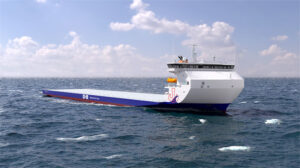
The 150-metre-long vessel will be operated by MOL Coastal Shipping under the management of MOL Drybulk, which currently operates a 3,700-tonne class module carrier on a time charter basis to transport onshore and offshore wind turbine components, plant cargo, marine equipment, and others in waters off the coast of Asia.
The new ship will be equipped with a dynamic positioning system (DPS) and will have a flat deck so it can directly load wind turbine components such as monopiles, towers, blades, nacelles, and floating foundations, from the stern and sides of the vessel using multi-axle trucks.
The vessel, equipped with electric propulsion and a battery pack, will transport components directly to jack-up vessels at offshore wind construction sites.
Japan currently has six operational offshore wind farms, with two of them being large-scale, the 84 MW Noshiro Port and the 54.6 MW Akita Port projects. The country had 153.5 MW of installed offshore wind capacity at the end of last year, not including semi-offshore wind farms accessible from coastal areas.
In March 2024, the Japanese Government passed an amendment to the “Act on Promoting the Utilization of Sea Areas”, expanding the area for setting up offshore wind to the Exclusive Economic Zone (EEZ), which would allow wind farms to be installed further out to sea from current territorial and internal waters.